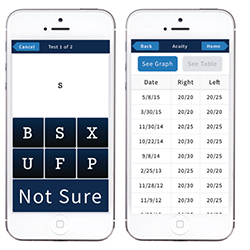For about two years, Dr. Moshfeghi, a professor of ophthalmology at Stanford University Medical Center, has sent upwards of 100 patients home with the mobile Checkup app from DigiSight Technologies. He has been a beta tester for the app.
 |
| The left screen shows the visual acuity test mode on the Checkup app, the right screen the results over time. |
Between clinic visits, once or twice a week, or more frequently if Dr. Moshfeghi prescribes it, patients take any number of visual function tests using the Checkup on a mobile device in their own home.
The app uploads the results to the cloud and sends him or his staff alerts if something untoward registers in the test results.
Checkup is one of three tools that DigiSight now integrates into its Paxos platform launched last year. The other tools include Paxos Scope, a hardware add-on with a mobile application that captures anterior and posterior images of the eye wherever the patient is, and Paxos Analytics, which enables real-time insight on clinical study outcomes with high-frequency longitudinal data not previously available. DigiSight expects to launch Analytics this year.
Tests patients can perform on Checkup include visual acuity, Amsler grid, low-light acuity, inverse acuity, contrast sensitivity, low light contrast, color discrimination, acuity and contrast, and the DigiGrid proprietary grid test.
‘Sense of Security’
Dr. Moshfeghi took time out from his retina specialty clinic to talk about how he’s used Checkup to follow patients with retinal disease. “This gives patients a sense of security that their vision is testing around where it was at the clinic, or maybe it’s a little up or down, but it doesn’t just rely on the patient,” he says. “It has its own proprietary algorithm that has preset inflection points that, if the patient’s test falls below a certain threshold, it will alert the monitoring physician.”
He adds, “Sometimes the patient’s vision will drop two lines and it doesn’t bother the patient, but the algorithm will notify us.”
When following patients with chronic retinal disease, retina specialists make most of their decisions based on empirical data. “While the patient hasn’t had fluid accumulate in the nine weeks before, we’ll have the patient follow up in nine weeks—but that doesn’t mean fluid can’t accumulate before that,” he says. “Because I know what kind of patient I’m dealing with—whether the patient has macular degeneration or RVO—and if the fluid does return earlier than expected, I can bring this patient in and see what’s going on.”
Age Is No Barrier
He has found the app to be suitable for any patient. “If patients are particularly anxious about their vision, I’ll put them on the app,” he says. “It gives them a lot of reassurance.” He has prescribed Checkup for patients as young as 10 years old.
“About 95 percent of the patients I’ve given it to take to it very easily,” Dr. Moshfeghi says. Getting the testing interval right is an important consideration for the clinician. “I first started them all on daily testing, but nobody does daily testing. If you put them on weekly or twice-weekly schedule, particularly for patients who are relatively stable, low-risk patients, they use it all the time,” he says.
He adds, “A lot of times when you call patients to follow up on a test, they are unaware the test picked up something, which only reinforces their belief in the system.”
Dr. Moshfeghi says of Checkup: “Having test-driven it, I think it’s ready for utilization. It can be a value-add to any practice.” RS
Dr. Moshfeghi disclosed he has no financial interest in DigiSight.




